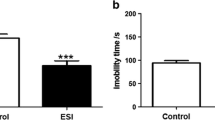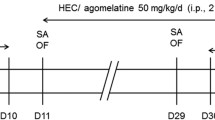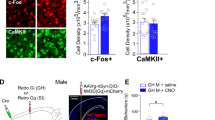Abstract
Social isolation (SI) is a notable model of prolonged mild stress, characterized by multiple neurochemical and behavioral alterations, that appears particularly suitable for studying different aspects of the interplay between stress and ethanol (EtOH) consumption in order to characterize potential molecular mechanisms, including changes in the function of inhibitory GABAergic synapses, underlying such interaction. In C57BL/6J mice, SI is associated with an altered hippocampal concentration of the neuroactive steroids 3α-hydroxy-5α-pregnan-20-one (3α-5α-THP), an increased expression of the α4 and δ subunit of γ-aminobutyric acid type A receptors (GABAARs) in the dentate gyrus (DG), and a parallel enhancement of the stimulatory action of 4,5,6,7-tetrahydroisoxazolo[5,4-c] pyridin-3-ol (THIP) on GABAergic tonic currents recorded in voltage-clamped DG granule cells (DGGCs). In addition, SI in C57BL/6J mice determines an increase in voluntary EtOH consumption and EtOH preference when compared to group-housed (GH) control animals. Furthermore, in hippocampal slices of SI mice we also observed a marked reduction of both cellular excitability and long term potentiation (LTP) in pyramidal neurons of the CA1 hippocampal sub-region, effects that were prevented by the long term treatment of SI mice with the neuroactive steroid precursor progesterone. In this article, we summarize some of our recent findings on the effects of SI in C57BL/6J mice on voluntary EtOH intake, regulation of GABAARs gene expression and function and hippocampal long term synaptic plasticity.

Similar content being viewed by others
References
Smith SM, Vale WW (2006) The role of the hypothalamic–pituitary–adrenal axis in neuroendocrine responses to stress. Dialogues Clin Neurosci 8:383–395
Becker HC, Lopez MF, Doremus-Fitzwater TL (2011) Effects of stress on alcohol drinking: a review of animal studies. Psychopharmacology 218(1):131–156. doi:10.1007/s00213-011-2443-9
Lopez MF, Doremus-Fitzwater TL, Becker HC (2011) Chronic social isolation and chronic variable stress during early development induce later elevated ethanol intake in adult C57BL/6J mice. Alcohol 218(1):131–156. doi:10.1016/j.alcohol.2010.08.017
Sanna E, Talani G, Obili N, Mascia MP, Mostallino MC, Secci PP, Pisu MG, Biggio F, Utzeri C, Olla P, Biggio G, Follesa P (2011) Voluntary ethanol consumption induced by social isolation reverses the increase of GABAA receptor gene expression and function in the hippocampus of C57BL/6J mice. Front Neurosci 5:15. doi:10.3389/fnins.2011.00015
Serra M, Mostallino MC, Talani G, Pisu MG, Carta M, Mura ML, Floris I, Maciocco E, Sanna E, Biggio G (2006) Social isolation-induced increase in alpha and delta subunit gene expression is associated with a greater efficacy of ethanol on steroidogenesis and GABA receptor function. J Neurochem 98:122–133. doi:10.1111/j.1471-4159.2006.03850.x
Lapiz MDS, Fulford A, Muchimapura S, Mason R, Parker T, Marsden CA (2003) Influence of postweaning social isolation in the rat on brain development, conditioned behavior, and neurotransmission. Neuroscience and Behavioral Physiology, 33(1). doi:10.1023/A:1021171129766
Serra M, Pisu MG, Littera M, Papi G, Sanna E, Tuveri F, Usala L, Purdy RH, Biggio G (2000) Social isolation-induced decreases in both the abundance of neuroactive steroids and GABAA receptor function in rat brain. J Neurochem 75:732–740. doi:10.1046/j.1471-4159.2000.0750732.x
Akana SF, Scribner KA, Bradbury MJ, Strack AM, Walker CD, Dallman MF (1992) Feedback sensitivity of the rat hypothalamo–pituitary–adrenal axis and its capacity to adjust to exogenous corticosterone. Endocrinology 131:585–594. doi:10.1210/en.131.2.585
Serra M, Pisu MG, Floris I, Cara V, Purdy RH, Biggio G (2003) Social isolation-induced increase in the sensitivity of rats to the steroidogenic effect of ethanol. J Neurochem 85:257–263. doi:10.1046/j.1471-4159.2003.01680.x
Wallner M, Hanchar HJ, Olsen RW (2003) Ethanol enhances α4β3δ and α6β3δ γ-aminobutyric acid type A receptors at low concentrations known to affect humans. Proc Natl Acad Sci USA 100:15218–15223. doi:10.1073/pnas.2435171100
Sundstrom-Poromaa I, Smith DH, Gong QH, Sabado TN, Li X, Light A, Wiedmann M, Williams K, Smith SS (2002) Hormonally regulated α4β2δ GABAA receptors are a target for alcohol. Nat Neurosci 5:721–722. doi:10.1038/nn888
Ueno S, Harris RA, Messing RO, Sanchez-Perez AM et al (2001) Alcohol actions on GABA(A) receptors: from protein structure to mouse behavior. Alcohol Clin Exp Res 25:76S–81S. doi:10.1111/j.1530-0277.2001.tb02378.x
Harris RA (1999) Ethanol actions on multiple ion channels: which are important? Alcohol Clin Exp Res 23:1563–1570. doi:10.1111/j.1530-0277.1999.tb04045.x
Faingold CL, N’Gouemo P, Riaz A (1998) Ethanol and neurotransmitter interactions—from molecular to integrative effects. Prog Neurobiol 55:509–535. doi:10.1016/S0301-0082(98)00027-6
Glykys J, Mann EO, Mody I (2008) Which GABA(A) receptor subunits are necessary for tonic inhibition in the hippocampus? J Neurosci 28(6):1421–1426. doi:10.1523/JNEUROSCI.4751-07.2008
Nusser Z, Mody I (2002) Selective modulation of tonic and phasic inhibitions in dentate gyrus granule cells. J Neurophysiol 87:2624–2628. doi:10.1152/jn.0 0866.2001
Glykys J, Peng Z, Chandra D, Homanics GE, Houser CR, Mody I (2007) A new naturally occurring GABAA receptor subunit partnership with high sensitivity to ethanol. Nat Neurosci 10:40–48. doi:10.1038/nn1813
Pirker S, Schwarzer C, Wieselthaler A, Sieghart W, Sperk G (2000) GABAA receptors: immunocytochemical distribution of 13 subunits in the adult rat brain. Neuroscience 101:815–850. doi:10.1016/S0306-4522(00)00442-5
Caraiscos VB, Elliott EM, You-Ten KE, Cheng VY, Belelli D, Newell JG, Jackson MF, Lambert JJ, Rosahl TW, Wafford KA, MacDonald JF, Orser BA (2004) Tonic inhibition in mouse hippocampal CA1 pyramidal neurons is mediated by α5 subunit-containing γ-aminobutyric acid type A receptors. Proc Natl Acad Sci USA 101:3662–3667. doi:10.1073/pnas.0307231101
Kumar S, Porcu P, Werner DF, Matthews DB, Diaz-Granados JL, Helfand RS, Morrow AL (2009) The role of GABA(A) receptors in the acute and chronic effects of ethanol: a decade of progress. Psychopharmacology 205(4):529–564. doi:10.1007/s00213-009-1562-z
Liang J, Suryanarayanan A, Abriam A, Snyder B, Olsen RW, Spigelman I (2007) Mechanisms of reversible GABAA receptor plasticity after ethanol intoxication. J Neurosci 27(45):12367–12377. doi:10.1523/JNEUROSCI.2786-07.2007
Smith SS, Gong QH, Hsu FC, Markowitz RS, ffrench-Mullen JM, Li X (1998) GABA(A) receptor alpha4 subunit suppression prevents withdrawal properties of an endogenous steroid. Nature 392(6679):926–930. doi:10.1038/31948
Smith SS, Gong QH, Li X, Moran MH, Bitran D, Frye CA, Hsu FC (1998) Withdrawal from 3alpha-OH-5alpha-pregnan-20-One using a pseudopregnancy model alters the kinetics of hippocampal GABAA-gated current and increases the GABAA receptor alpha4 subunit in association with increased anxiety. J Neurosci 18(14):5275–5284
Liang J, Zhang N, Cagetti E, Houser CR, Olsen RW, Spigelman I (2006) Chronic intermittent ethanol induced switch of ethanol actions from extrasynaptic to synaptic hippocampal GABAA receptors. J Neurosci 26:1749–1758. doi:10.1523/JNEUROSCI.4702-05.2006
Hall FS, Huang S, Fong GW, Pert A, Linnoila M (1998) Effects of isolation-rearing on voluntary consumption of ethanol, sucrose and saccharin solutions in Fawn Hooded and Wistar rats. Psychopharmacology 139:210–216. doi:10.1007/s002130050706
Schenk S, Gorman K, Amit Z (1990) Age-dependent effects of isolation housing on the self-administration of ethanol in laboratory rats. Alcohol 7:321–326. doi:10.1016/0741-8329(90)90090-Y
Wolffgramm J (1990) Free choice ethanol intake of laboratory rats under different social conditions. Psychopharmacology 101:233–239
Izumi Y, Murayama K, Tokuda K, Covey D, Zorumski CF (2007) GABAergic neurosteroids mediate the effects of ethanol on long-term potentiation in rat hippocampal slices. Eur J Neurosci 26:1881–1888. doi:10.1111/j.1460-9568.2007.05809.x
Izumi Y, Nagashima K, Murayama K, Zorumski CF (2005) Acute effects of ethanol on hippocampal long-term potentiation and longterm depression are mediated by different mechanisms. Neuroscience 136:509–517. doi:10.1016/j.neuroscience.2005.08.002
Mayford M (2007) Protein kinase signaling in synaptic plasticity and memory. Curr Opin Neurobiol 17:313–317. doi:10.1016/j.conb.2007.05.001
Tombaugh GC, Rowe WB, Rose GM (2005) The slow afterhyperpolarization in hippocampal CA1 neurons covaries with spatial learning ability in aged Fisher 344 rats. J Neurosci 25:2609–2616. doi:10.1523/JNEUROSCI.5023-04.2005
Moyer JR Jr, Thompson LT, Disterhoft JF (1996) Trace eyeblink conditioning increases CA1 excitability in a transient and learning-specific manner. J Neurosci 16:5536–5546
Moyer JR Jr, Power JM, Thompson LT, Disterhoft JF (2000) Increased excitability of aged rabbit CA1 neurons after trace eyeblink conditioning. J Neurosci 20:5476–5482
Thompson LT, Moyer JR, Disterhoft JF (1996) Transient changes in excitability of rabbit CA3 neurons with a time course appropriate to support memory consolidation. J Neurophysiol 76:1836–1849
Matsumoto K, Uzunova V, Pinna G, Taki K, Uzunov DP, Watanabe H, Mienville JM, Guidotti A, Costa E (1999) Permissive role of brain allopregnanolone content in the regulation of pentobarbital induced righting reflex loss. Neuropharmacology 38:955–963. doi:10.1016/S0028-3908(99)00018-0
Agís-Balboa RC, Pinna G, Pibiri F, Kadriu B, Costa E, Guidotti A (2007) Down-regulation of neurosteroid biosynthesis in corticolimbic circuits mediates social isolation-induced behavior in mice. Proc Natl Acad Sci USA 104(47):18736–18741. doi:10.1073/pnas.0709419104
Brown N, Kerby J, Bonnert TP, Whiting PJ, Wafford KA (2002) Pharmacological characterization of a novel cell line expressing human α(4)β(3)δ GABA(A) receptors. Br J Pharmacol 136:965–974. doi:10.1038/sj.bjp.0704795
Adkins CE, Pillai GV, Kerby J, Bonnert TP, Haldon C, McKernan RM, Gonzalez JE, Oades K, Whiting PJ, Simpson PB (2001) α4β3δ GABA(A) receptors characterized by fluorescence resonance energy transfer-derived measurements of membrane potential. J Biol Chem 276:38934–38939. doi:10.1074/jbc.M104318200
Talani G, Biggio G, Sanna E (2011). Enhanced Sensitivity to Ethanol-Induced Inhibition of LTP in CA1 Pyramidal Neurons of Socially Isolated C57BL/6J Mice: Role of Neurosteroids. Front Endocrinol (Lausanne). doi: 10.3389/fendo.2011.00056
Bartesaghi R (2004) Effect of early isolation on the synaptic function in the dentate gyrus and field CA1 of the guinea pig. Hippocampus 14:482–498. doi:10.1002/hipo.10201
Conrad KL, Louderback KM, Gessner CP, Winder DG (2011) Stress-induced alterations in anxiety-like behavior and adaptations in plasticity in the bed nucleus of the stria terminalis. Physiol Behav 104:248–256. doi:10.1016/j.physbeh.2011.03.001
Bianchi M, Fone KF, Azmi N, Heidbreder CA, Hagan JJ, Marsden CA (2006) Isolation rearing induces recognition memory deficits accompanied by cytoskeletal alterations in rat hippocampus. Eur J Neurosci 24:2894–2902. doi:10.1111/j.1460-9568.2006.05170.x
Roberts L, Greene JR (2003) Post-weaning social isolation of rats leads to a diminution of LTP in the CA1 to subiculum pathway. Brain Res 991:271–273. doi:10.1016/j.brainres.2003.08.022
Morrisett RA, Swartzwelder HS (1993) Attenuation of hippocampal long-term potentiation by ethanol: a patch-clamp analysis of glutamatergic and GABAergic mechanisms. J Neurosci 13:2264–2272
Yin HH, Park BS, Adermark L, Lovinger DM (2007) Ethanol reverses the direction of long-term synaptic plasticity in the dorsomedial striatum. Eur J Neurosci 25:3226–3232. doi:10.1111/j.1460-9568.2007.05606.x
Belmeguenai A, Botta P, Weber JT, Carta M, De Ruiter M, De Zeeuw CI, Valenzuela CF, Hansel C (2008) Alcohol impairs long-term depression at the cerebellar parallel fiber–Purkinje cell synapse. J Neurophysiol 100:3167–3174. doi:10.1152/jn.9 0384.2008
Sanna E, Talani G, Busonero F, Pisu MG, Purdy RH, Serra M, Biggio G (2004) Brain steroidogenesis mediates ethanol modulation of GABAA receptor activity in rat hippocampus. J Neurosci 24:6521–6530. doi:10.1523/JNEUROSCI.0075-04.2004
Finn DA, Beadles-Bohling AS, Beckley EH, Ford MM, Katherine R, Gililland KR, Gorin-Meyer RE, Wiren KM (2006) A new look at the 5α-reductase inhibitor finasteride. CNS Drug Rev 12:53–76. doi:10.1111/j.1527-3458.2006.00053.x
Voikar V, Polus A, Vasar E, Rauvala H (2005) Long-term individual housing in C57BL/6J and DBA/2 mice: assessment of behavioral consequences. Genes Brain Behav 4:240–252. doi:10.1111/j.1601-183X.2004.00106.x
Quan MN, Tian YT, Xu KH, Zhang T, Yang Z (2010) Post weaning social isolation influences spatial cognition, prefrontal cortical synaptic plasticity and hippocampal potassium ion channels in Wistar rats. Neuroscience 169:214–222. doi:10.1016/j.neuroscience.2010.04.048
Lu L, Bao G, Chen H, Xia P, Fan X, Zhang J, Pei G, Ma L (2003) Modification of hippocampal neurogenesis and neuroplasticity by social isolation. Exp Neurol 183:600–609. doi:10.1016/S0014-4886(03)00248-6
Pisu MG, Mostallino MC, Dore R, Maciocco E, Secci PP, Serra M (2010) Effects of voluntary ethanol consumption on emotional state and stress responsiveness in socially isolated rats. Eur Neuropsychopharmacol 21(5):414–425. doi:10.1016/j.euroneuro.2010.07.006
Moran MH, Goldberg M, Smith SS (1998) Progesterone withdrawal. II: insensitivity to the sedative effect of a benzodiazepine. Brain Res 807:91–100. doi:10.1016/j.bbr.2011.03.031
Advani T, Hensler JG, Koek W (2007) Effect of early rearing conditions on alcohol drinking and 5-HT1A receptor function in C57BL/6J mice. Int J Neuropsychopharmacol 10:595–607. doi:10.1017/S1461145706007401
Yanai J, Ginsburg BE (1976) Increased sensitivity to chronic ethanol in isolated mice. Psychopharmacologia 46:185–189
Cruz FC, Quadros IM, Planeta Cda S, Miczek KA (2008) Maternal separation stress in male mice: long-term increases in alcohol intake. Psychopharmacology 201:459–468. doi:10.1007/s00213-008-1307-4
Morrow AL, Janis GC, VanDoren MJ, Matthews DB, Samson HH, Janak PH, Grant KA (1999) Neurosteroids mediate pharmacological effects of ethanol: a new mechanism of ethanol action? Alcohol Clin Exp Res 23:1933–1940. doi:10.1111/j.1530-0277.1999.tb04094.x
Porcu P, O’Buckely TK, Alward SE, Song SC, Grant KA, de Wit H, Leslie Morrow A (2010) Differential effects of ethanol on serum GABAergic 3alpha, 5alpha/3alpha,5beta neuroctive steroids in mice, rats, cynomolggus monkeys, and humans. Alcohol Clin Exp Res 34(3):432–442. doi:10.1111/j.1530-0277.2009.01123
Follesa P, Mostallino MC, Biggio F, Gorini G, Caria S, Busonero F, Murru L, Mura ML, Sanna E, Biggio G (2005) Distinct patterns of expression and regulation of GABA receptors containing the delta subunit in cerebellar granule and hippocampal neurons. J Neurochem 94:659–671. doi:10.1111/j.1471-4159.2005.03303.x
Sanna E, Mostallino MC, Busonero F, Talani G, Tranquilli S, Mameli M, Spiga S, Follesa P, Biggio G (2003) Changes in GABA(A) receptor gene expression associated with selective alterations in receptor function and pharmacology after ethanol withdrawal. J Neurosci 23:11711–11724
Ariwodola OJ, Weiner JL (2004) Ethanol potentiation of GABAergic synaptic transmission may be self-limiting: role of presynaptic GABA(B) receptors. J Neurosci 24:10679–10686. doi:10.1523/JNEUROSCI.1768-04.2004
Carta M, Mameli M, Valenzuela CF (2004) Alcohol enhances GABAergic transmission to cerebellar granule cells via an increase in Golgi cell excitability. J Neurosci 24:3746–3751. doi:10.1523/JNEUROSCI.0067-04.2004
Roberto M, Madamba SG, Moore SD, Tallent MK, Siggins GR (2003) Ethanol increases GABAergic transmission at both pre- and postsynaptic sites in rat central amygdala neurons. Proc Natl Acad Sci USA 100:2053–2058. doi:10.1073/pnas.0437926100
Kelm MK, Weinberg RJ, Criswell HE, Breese GR (2010) The PLC/IP 3 R/PKC pathway is required for ethanol-enhanced GABA release. Neuropharmacology 58:1179–1186. doi:10.1016/j.neuropharm.2010.02.018
Kelm MK, Criswell HE, Brees GR (2008) The role of protein kinase A in the ethanol-induced increase in spontaneous GABA release onto cerebellar Purkinje neurons. J Neurophysiol 100:3417–3428. doi:10.1152/jn.9 0970.2008
Werner DF, Kumar S, Criswell HE, Suryanarayanan A, Fetzer JA, Comerford CE, Morrow AL (2011) PKCγ is required for ethanol-induced increases in GABA(A) receptor α4 subunit expression in cultured cerebral cortical neurons. J Neurochem 116(4):554–563. doi:10.1111/j.1471-4159.2010.07140.x
Author information
Authors and Affiliations
Corresponding author
Rights and permissions
About this article
Cite this article
Talani, G., Licheri, V., Masala, N. et al. Increased Voluntary Ethanol Consumption and Changes in Hippocampal Synaptic Plasticity in Isolated C57BL/6J Mice. Neurochem Res 39, 997–1004 (2014). https://doi.org/10.1007/s11064-013-1216-8
Received:
Revised:
Accepted:
Published:
Issue Date:
DOI: https://doi.org/10.1007/s11064-013-1216-8




